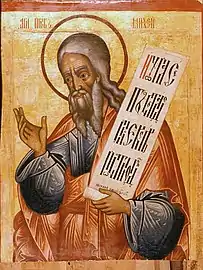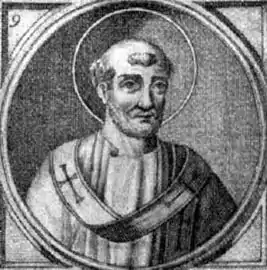January 5 (Eastern Orthodox liturgics)
January 4 - Eastern Orthodox liturgical calendar - January 6
All fixed commemorations below are observed on January 18 by Orthodox Churches on the Old Calendar.[note 1]
For January 5th, Orthodox Churches on the Old Calendar commemorate the Saints listed on December 23.
Feasts
- Eve of the Theophany of Our Lord and Saviour Jesus Christ.[1]
Saints
- Prophet Micah (9th century BC)[1] (see also: August 14)
- Martyr Theopemptus, Bishop of Nicomedia and Martyr Theonas, former sorcerer (303)[1][2]
- Martyr Sais.[3]
- Martyr Theoidus.[4]
- Saint Syncletica of Alexandria, nun (c. 350 or c. 460)[1])[5]
- Venerable Domnina (Domna).[6]
- Venerable Tatiana, nun.[7]
- Saint Apollinaris, Virgin, of Egypt (c. 470)[1][8]
- Venerable Phosterius the Hermit (6th century)[1][9]
- Saint Menas of Sinai (6th century)[1]
- Venerable Gregory of Crete, monk (c. 820)[1][10]
- Venerable Dorotheos the Younger, restorer of the ancient Monastery of the Holy Trinity at Chiliokomon in Amaseia, Pontus.[11][note 2]
Pre-Schism Western saints
- Hieromartyr Saint Telesphorus, a Greek who was Pope of Rome for ten years (c. 136)[13][note 3] (see also February 22, Eastern Orthodox)
- Saint Emiliana, a Roman lady and the paternal aunt of Pope St Gregory the Great (6th century)[13][note 4]
- Saint Kiara (Chier), a spiritual daughter of St Fintan Munnu; she lived in Ireland near Nenagh in Co. Tipperary, at a place now called Kilkeary after her (c. 680)[13]
- Venerable Cera of Ireland (Ciar, Cyra, Cior, Ceara), Abbess (7th century)[13][note 5]
- Venerable Conwoïon (Convoyon), a Breton saint and Abbot (868)[13][note 6]
- Saint Gaudentius of Gnesen (Radim Gaudentius), first Archbishop of Gnesen in Poland (1004)[13][note 7]
Post-Schism Orthodox saints
- New Monk-martyr Romanus of Carpenision and Kapsokalyvia, at Constantinople (1694)[1][14] (see also February 16)
- Venerable Symeon of the Pskov-Caves Monastery, Hiero-Schemamonk (1960)[1][15]
- Venerable Theophan, Schema-Archimandrite of the Rykhlovsk Monastery (ru), Ukraine (1977)[1]
New martyrs and confessors
- New Hieromartyr Archpriest Andrei Zimin (1920)[16][17]
- New Hieromartyr Joseph Bespalov, and with him 37 Martyrs (1921)[15][18][19]
- Hieromartyr Stephen Ponomarev, Protopresbyter, at Alma-Ata (1933)[18]
- Virgin-martyr Eugenia Domozhirova, at Alma-Ata (1933)[15][18][19]
- New Hieromartyr Sergius Lavrov, Priest (1934)[15][19]
- Martyr Matthew Gusev (1938)[15][19]
Other commemorations
- Translation of the relics of St. Rumon, Bishop, to Tavistock Abbey.[15]
- Repose of Monk Alexander of Valaam Monastery (1810)[1]
Icon gallery
 Prophet Micah (18th-century icon)
Prophet Micah (18th-century icon).jpg.webp) Martyrdom of Theopemptus, Bishop of Nicomedia and Theonas, former sorcerer (Menologion of Basil II, 10th century)
Martyrdom of Theopemptus, Bishop of Nicomedia and Theonas, former sorcerer (Menologion of Basil II, 10th century).jpg.webp) Saint Syncletica of Alexandria (Menologion of Basil II, 10th century)
Saint Syncletica of Alexandria (Menologion of Basil II, 10th century) Hieromartyr Saint Telesphorus, Pope of Rome.
Hieromartyr Saint Telesphorus, Pope of Rome.
Notes
- The notation Old Style or (OS) is sometimes used to indicate a date in the Julian Calendar (which is used by churches on the "Old Calendar").
The notation New Style or (NS), indicates a date in the Revised Julian calendar (which is used by churches on the "New Calendar"). - "A homily, which is written in the form of a Vita by John Mauropous, metropolitan of Euchaita, on St. Dorotheos the Younger, gives the information that the monastery of Chryse Petra was not very far from Chiliokomon (the plain with a thousand towns, today Sulu-ova = the plain of the waters) where St. Dorotheos had restored the ancient monastery of Holy Trinity and had received the typikon of the monastery of Chryse Petra: ...καί της χρυσής καλούμενης πέτρας (ούδ' εκείνη δε πόρρω). This short reference reveals that the monastery of Chryse Petra was near Chiliokomon, and in a wider sense, near the Iris river."[12]
- "At Rome, in the time of Antoninus Pius, St. Telesphorus, pope, who, after many sufferings for the confession of Christ, underwent a glorious martyrdom."[8]
- "At Rome, the holy virgin Emiliana, aunt of pope St. Gregory. Being called to God by her sister Tharsilla, who had preceded her, she departed for heaven on this day."[8]
- "Born in Tipperary in Ireland, she was abbess of two convents, one at Kilkeary and the other at Tech Telle, now Tehelly."
- "Born in Brittany, he became a monk and founded the Monastery of St Saviour near Redon (Redon Abbey). He was driven out of his monastery by the Vikings and reposed in exile."
- "Younger brother of St Adalbert of Prague and also a monk at the monastery of Sant' Alessio on the Aventine in Rome. He escaped the massacre in which his brother was martyred by the pagan Prussians and in 1000 became first Archbishop of Gnesen in Poland."
References
- January 5/January 18. Orthodox Calendar (PRAVOSLAVIE.RU).
- Great Synaxaristes: (in Greek): Οἱ Ἅγιοι Θεόπεμπτος καὶ Θεωνᾶς. 5 ΙΑΝΟΥΑΡΙΟΥ. ΜΕΓΑΣ ΣΥΝΑΞΑΡΙΣΤΗΣ.
- Great Synaxaristes: (in Greek): Ὁ Ἅγιος Σάϊς ὁ Μάρτυρας. 5 ΙΑΝΟΥΑΡΙΟΥ. ΜΕΓΑΣ ΣΥΝΑΞΑΡΙΣΤΗΣ.
- Great Synaxaristes: (in Greek): Ὁ Ἅγιος Θεόειδος ὁ Μάρτυρας. 5 ΙΑΝΟΥΑΡΙΟΥ. ΜΕΓΑΣ ΣΥΝΑΞΑΡΙΣΤΗΣ.
- Great Synaxaristes: (in Greek): Ἡ Ἁγία Συγκλητική. 5 ΙΑΝΟΥΑΡΙΟΥ. ΜΕΓΑΣ ΣΥΝΑΞΑΡΙΣΤΗΣ.
- Great Synaxaristes: (in Greek): Ἡ Ὁσία Δομνίνα. 5 ΙΑΝΟΥΑΡΙΟΥ. ΜΕΓΑΣ ΣΥΝΑΞΑΡΙΣΤΗΣ.
- Great Synaxaristes: (in Greek): Ἡ Ὁσία Τατιανή. 5 ΙΑΝΟΥΑΡΙΟΥ. ΜΕΓΑΣ ΣΥΝΑΞΑΡΙΣΤΗΣ.
- The Roman Martyrology. Transl. by the Archbishop of Baltimore. Last Edition, According to the Copy Printed at Rome in 1914. Revised Edition, with the Imprimatur of His Eminence Cardinal Gibbons. Baltimore: John Murphy Company, 1916. p.6.
- Great Synaxaristes: (in Greek): Ὁ Ὅσιος Φωστήριος. 5 ΙΑΝΟΥΑΡΙΟΥ. ΜΕΓΑΣ ΣΥΝΑΞΑΡΙΣΤΗΣ.
- Great Synaxaristes: (in Greek): Ὁ Ὅσιος Γρηγόριος ὁ ἐν Ἀκρίτᾳ. 5 ΙΑΝΟΥΑΡΙΟΥ. ΜΕΓΑΣ ΣΥΝΑΞΑΡΙΣΤΗΣ.
- Great Synaxaristes: (in Greek): Ὁ Ὅσιος Δωρόθεος. 5 ΙΑΝΟΥΑΡΙΟΥ. ΜΕΓΑΣ ΣΥΝΑΞΑΡΙΣΤΗΣ.
- Eleonora Kountoura-Galake. The Location of the Monastery of Chryse Petra. 1999. p.73.
- January 5. Latin Saints of the Orthodox Patriarchate of Rome.
- Great Synaxaristes: (in Greek): Ὁ Ἅγιος Ρωμανὸς ὁ Ὁσιομάρτυρας. 5 ΙΑΝΟΥΑΡΙΟΥ. ΜΕΓΑΣ ΣΥΝΑΞΑΡΙΣΤΗΣ.
- January 18 / January 5. HOLY TRINITY RUSSIAN ORTHODOX CHURCH (A parish of the Patriarchate of Moscow).
- RUSSIAN SYNOD ADDS FOUR NAMES TO SYNAXIS OF NEW MARTYRS AND CONFESSORS. Orthodox Christianity. Moscow, April 5, 2019.
- (in Russian) ЖУРНАЛЫ заседания Священного Синода от 4 апреля 2019 года. Русская Православная Церковь, Официальный сайт Московского Патриархата (Патриархия.ru). 4 апреля 2019 г. 15:00.
- The Autonomous Orthodox Metropolia of Western Europe and the Americas (ROCOR). St. Hilarion Calendar of Saints for the year of our Lord 2004. St. Hilarion Press (Austin, TX). p.5.
- (in Russian) 5 января (ст.ст.) 18 января 2013 (нов. ст.). Русская Православная Церковь Отдел внешних церковных связей. (DECR).
Sources
- January 5/January 18. Orthodox Calendar (PRAVOSLAVIE.RU).
- January 18 / January 5. HOLY TRINITY RUSSIAN ORTHODOX CHURCH (A parish of the Patriarchate of Moscow).
- January 5. OCA - The Lives of the Saints.
- The Autonomous Orthodox Metropolia of Western Europe and the Americas (ROCOR). St. Hilarion Calendar of Saints for the year of our Lord 2004. St. Hilarion Press (Austin, TX). p. 5.
- January 5. Latin Saints of the Orthodox Patriarchate of Rome.
- The Roman Martyrology. Transl. by the Archbishop of Baltimore. Last Edition, According to the Copy Printed at Rome in 1914. Revised Edition, with the Imprimatur of His Eminence Cardinal Gibbons. Baltimore: John Murphy Company, 1916. p. 6.
Greek Sources
- Great Synaxaristes: (in Greek) 5 ΙΑΝΟΥΑΡΙΟΥ. ΜΕΓΑΣ ΣΥΝΑΞΑΡΙΣΤΗΣ.
- (in Greek) Συναξαριστής. 5 Ιανουαρίου. ECCLESIA.GR. (H ΕΚΚΛΗΣΙΑ ΤΗΣ ΕΛΛΑΔΟΣ).
Russian Sources
- (in Russian) 18 января (5 января). Православная Энциклопедия под редакцией Патриарха Московского и всея Руси Кирилла (электронная версия). (Orthodox Encyclopedia - Pravenc.ru).
- (in Russian) 5 января (ст.ст.) 18 января 2013 (нов. ст.). Русская Православная Церковь Отдел внешних церковных связей. (DECR).
This article is issued from Wikipedia. The text is licensed under Creative Commons - Attribution - Sharealike. Additional terms may apply for the media files.

